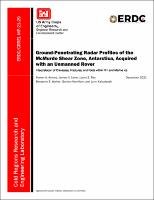Please use this identifier to cite or link to this item:
https://hdl.handle.net/11681/42620Full metadata record
| DC Field | Value | Language |
|---|---|---|
| dc.contributor.author | Arcone, Steven A. | - |
| dc.contributor.author | Lever, J. H. | - |
| dc.contributor.author | Ray, Laura E. | - |
| dc.contributor.author | Kaluzienski, Lynn M. | - |
| dc.contributor.author | Hamilton, Gordon | en_US |
| dc.contributor.author | Walker, Benjamin S. | - |
| dc.date.accessioned | 2021-12-15T14:18:57Z | - |
| dc.date.available | 2021-12-15T14:18:57Z | - |
| dc.date.issued | 2021-12 | - |
| dc.identifier.govdoc | ERDC/CRREL MP-21-29 | - |
| dc.identifier.uri | https://hdl.handle.net/11681/42620 | - |
| dc.identifier.uri | http://dx.doi.org/10.21079/11681/42620 | - |
| dc.description | Miscellaneous Paper | en_US |
| dc.description.abstract | The crevassed firn of the McMurdo shear zone (SZ) within the Ross Ice Shelf may also contain crevasses deep within its meteoric and marine ice, but the surface crevassing prevents ordinary vehicle access to investigate its structure geophysically. We used a lightweight robotic vehicle to tow 200- and 40 MHz ground-penetrating radar antennas simultaneously along 10 parallel transects over a 28 km² grid spanning the SZ width. Transects were generally orthogonal to the ice flow. Total firn and meteoric ice thickness was approximately 160 m. Firn crevasses profiled at 400 MHz were up to 16 m wide, under snow bridges up to 10 m thick, and with strikes near 35°–40° to the transect direction. From the top down, 200- MHz profiles revealed firn diffractions originating to a depth of approximately 40 m, no discernible structure within the meteoric ice, a discontinuous transitional horizon, and at least 20 m of stratified marine ice; 28–31 m of freeboard found more marine ice exists. Based on 10 consecutive transects covering approximately 2.5 km², we preliminarily interpreted the transitional horizon to be a thin saline layer, and marine ice hyperbolic diffractions and reflections to be responses to localized fractures, and crevasses filled with unstratified marine ice, all at strikes from 27° to 50°. We preliminarily interpreted off nadir, marine ice horizons to be responses to linear and folded faults, similar to some in firn. The coinciding and synchronously folded areas of fractured firn and marine ice suggested that the visibly unstructured meteoric ice beneath our grid was also fractured, but either never crevassed, crevassed and sutured without marine ice inclusions, or that any ice containing crevasses might have eroded before marine ice accretion. We will test these interpretations with analysis of all transects and by extending our grid and increasing our depth ranges. | en_US |
| dc.description.sponsorship | National Science Foundation (U.S.) | en_US |
| dc.format.extent | 20 pages / 2.41 MB | - |
| dc.format.medium | PDF/A | - |
| dc.language.iso | en_US | en_US |
| dc.publisher | Cold Regions Research and Engineering Laboratory (U.S.) | en_US |
| dc.publisher | Engineer Research and Development Center (U.S.) | - |
| dc.relation.ispartofseries | Miscellaneous Paper (Engineer Research and Development Center (U.S.)) ; no. ERDC/CRREL MP-21-29 | - |
| dc.relation.isversionof | Arcone, Steven A., James H. Lever, Laura E. Ray, Benjamin S. Walker, Gordon Hamilton, and Lynn Kaluzienski. "Ground-penetrating radar profiles of the McMurdo Shear Zone, Antarctica, acquired with an unmanned rover: interpretation of crevasses, fractures, and folds within firn and marine ice." Geophysics 81, no. 1 (2016): WA21-WA34. https://doi.org/10.1190/geo2015-0132.1 | - |
| dc.rights | Approved for Public Release; Distribution is Unlimited | - |
| dc.source | This Digital Resource was created in Microsoft Word and Adobe Acrobat | - |
| dc.subject | Ground penetrating radar | en_US |
| dc.subject | Autonomous robots | en_US |
| dc.subject | Glacial crevasses | en_US |
| dc.subject | Ice | en_US |
| dc.subject | McMurdo Ice Shelf (Antarctica) | en_US |
| dc.subject | Ross Ice Shelf (Antarctica) | en_US |
| dc.title | Ground-penetrating radar profiles of the McMurdo shear zone, Antarctica, acquired with an unmanned rover : interpretation of crevasses, fractures, and folds within firn and marine ice | en_US |
| dc.type | Report | en_US |
| Appears in Collections: | Miscellaneous Paper | |
Files in This Item:
| File | Description | Size | Format | |
|---|---|---|---|---|
| ERDC-CRREL MP-21-29.pdf | 2.41 MB | Adobe PDF |  View/Open |